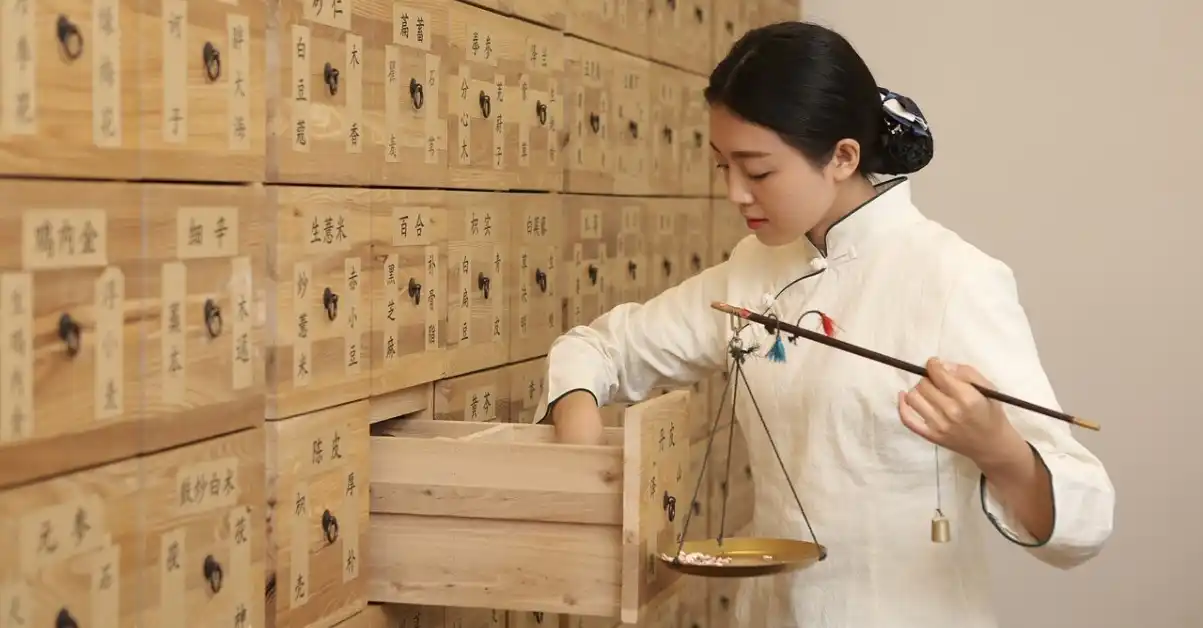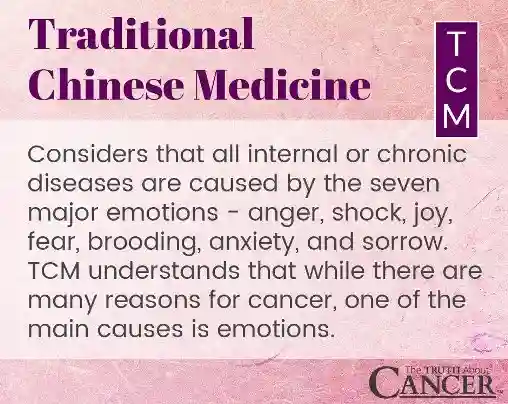
Traditional Chinese Medicine
What is Traditional Chinese Medicine?
Traditional Chinese medicine (TCM) originated in ancient China and has evolved over thousands of years. TCM practitioners use herbal medicines and various mind and body practices, such as acupuncture, Tai Chi, massage (Tui na), exercise (qigong), and dietary therapy to treat or prevent health problems.
This 2019 Review published in the journal Cancer Medicine concluded:
TCM‐based CHM has increasingly been shown to exhibit promising therapeutic effects as an adjunctive treatment following surgery, chemotherapy, radiotherapy, or other types of therapy for cancer patients worldwide. CHM is considered a gift of nature and these compounds derived from herbs have the advantage of availability, efficacy, and relatively low toxicity compared with chemotherapy. Evidence has confirmed that TCM in combination with chemotherapy or radiotherapy is capable of promoting the efficacy of and diminishing the limitations and drawbacks induced by chemotherapy and radiotherapy.

Traditional Chinese Medicine: An Introduction
Source: National Center for Complementary and Alternative Medicine
Underlying Concepts
Underlying the practice of TCM is a unique view of the world and the human body that is different from Western medicine concepts. This view is based on the ancient Chinese perception of humans as microcosms of the larger, surrounding universe—interconnected with nature and subject to its forces. The human body is regarded as an organic entity in which the various organs, tissues, and other parts have distinct functions but are all interdependent. In this view, health and disease relate to balance of the functions.
The theoretical framework of TCM has a number of key components:
- Yin-yang theory—the concept of two opposing, yet complementary, forces that shape the world and all life—is central to TCM.
- In the TCM view, a vital energy or life force called qi circulates in the body through a system of pathways called meridians. Health is an ongoing process of maintaining balance and harmony in the circulation of qi.
- The TCM approach uses eight principles to analyze symptoms and categorize conditions: cold/heat, interior/exterior, excess/deficiency, and yin/yang (the chief principles). TCM also uses the theory of five elements—fire, earth, metal, water, and wood—to explain how the body works; these elements correspond to particular organs and tissues in the body.
These concepts are documented in the Huang Di Nei Jing (Inner Canon of the Yellow Emperor), the classic Chinese medicine text.
Treatment
TCM emphasizes individualized treatment. Practitioners traditionally used four methods to evaluate a patient’s condition: observing (especially the tongue), hearing/smelling, asking/interviewing, and touching/palpating (especially the pulse).
TCM practitioners use a variety of therapies in an effort to promote health and treat disease. The most commonly used are Chinese herbal medicine and acupuncture.
- Chinese herbal medicine. The Chinese materia medica (a pharmacological reference book used by TCM practitioners) contains hundreds of medicinal substances—primarily plants, but also some minerals and animal products—classified by their perceived action in the body. Different parts of plants such as the leaves, roots, stems, flowers, and seeds are used. Usually, herbs are combined in formulas and given as teas, capsules, tinctures, or powders.
- Acupuncture. By stimulating specific points on the body, most often by inserting thin metal needles through the skin, practitioners seek to remove blockages in the flow of qi.
Other TCM therapies include moxibustion (burning moxa—a cone or stick of dried herb, usually mugwort—on or near the skin, sometimes in conjunction with acupuncture); cupping (applying a heated cup to the skin to create a slight suction); Chinese massage; mind-body therapies such as qi gong and tai chi; and dietary therapy.
Studies
In this study, 1132 patients with prostate cancer were enrolled.
Compared with TCM nonusers, patients who use TCM for more than 50 days have a lower risk of death. The risk of death in patients who used TCM for 50 to 200 days and ≧200 days decreased by 31% and 39%, respectively.
TCM users in the metastatic prostate cancer group had a significant better survival rate compared with TCM nonusers …
The mortality risk in the localized or locally advanced and castration-resistant prostate cancer groups was not significantly different between TCM users and nonusers.
The TCM formulae, Chai-Hu-Jia-Long-Gu-Mu-Li-Tang, had the most significant improvement in the survival rate of metastatic prostate cancer patients.
This study says: By reducing side effects and complications during chemo- and radio-therapy, these Chinese herbal medicines have a significant effect on reducing cancer-related fatigue and pain, improving respiratory tract infections and gastrointestinal side effects including diarrhea, nausea, and vomiting, protecting liver function, and even ameliorating the symptoms of cachexia.
This study
A total of 729 patients with advanced breast cancer receiving taxanes were included in the current study.
CONCLUSIONS: The results of the current observational study suggest that adjunctive TCM therapy may lower the risk of death in patients with advanced breast cancer
Therapeutic Effects of Ten Commonly Used Chinese Herbs and Their Bioactive Compounds on Cancers
This 2019 Review lists Ten Commonly Used Herbs
Oldenlandia diffusa (OD, Bai Hua She She Cao in Chinese)
Curcuma longa (CL, Jiang Huang in Chinese)
Astragalus membranaceus (AM, Huang Qi in Chinese)
Panax ginseng (PG, Ren Shen in Chinese)
Ganoderma lucidum (GL, Ling Zhi in Chinese)
Angelica sinensis (AS, Dang Gui in Chinese)
Panax notoginseng (PN, San Qi in Chinese)
Scutellaria barbata D. Don (SB, Ban Zhi Lian in Chinese)
Licorice (Gan Cao in Chinese)
Radix Salvia miltiorrhiza (SM, Dan Shen in Chinese)
Note: Licorice, American, Panax, and Siberian ginseng all have estrogenic effects; therefore, women with hormone-sensitive cancers should avoid these herbs (Eagon et al., 2000).
This 2019 Review in Chinese herbal medicine and cancer focuses on summarizing experimental results and conclusions from English literatures reported since 2011.
Curcumin
Numerous studies have shown that curcumin and its preparations can inhibit tumors in almost all parts of the body, including head and neck, ovarian, skin and gastric cancers.
Epigallocatechin gallate (EGCG)
It is reported to present anti-cancer effects in variety of cancer cells, including lung, colorectal, prostate, stomach, liver, cervical, breast, leukemia, gastric, bladder cancers .
Berberine
It exhibits significant anti-cancer effects in a wide spectrum of cancers including ovarian, breast, esophageal, and thyroid cancers, leukemia, multiple myeloma, nasopharyngeal carcinoma, and neuroblastoma, through inducing cell cycle arrest and apoptosis, inhibiting metastasis and angiogenesis.
Artemisinins
The anti-cancer effects of ARTs [artemisinin and its derivatives] are demonstrated in a broad spectrum of cancer cells including lung, liver, pancreatic, colorectal, esophageal, breast, ovarian, cervical, head and neck, and prostate cancers.
Ginsenosides
Ginsenosides mainly exert anti-cancer effects in colorectal, breast, liver and lung cancers, through inhibiting cell proliferation and migration, angiogenesis, and reversing drug resistance.
Ursolic acid (UA)
It also exerts anti-cancer activities in ovarian, breast, gastric, prostate, lung, liver, bladder, pancreatic, and colorectal cancers.
Silibinin
Previous studies have reported that silibinin exerts remarkable effects in numerous cancers such as renal, hepatocellular and pancreatic carcinoma, bladder, breast, colorectal, ovarian, lung, salivary gland, prostate and gastric cancers, through the induction of apoptosis, inhibition of tumor growth, metastasis and angiogenesis.
Emodin
Many studies have shown that emodin can attenuate numerous cancers including nasopharyngeal, gall bladder, lung, liver, colorectal, oral, ovarian, bladder, prostate, breast, stomach and pancreatic cancers, through the inhibition of cell proliferation and growth, metastasis, angiogenesis, and induction of apoptosis.
Tanshinones
Tanshinone exhibits anti-cancer activities in stomach, prostate, lung, breast, and colon cancers, through inducing cell cycle arrest, apoptosis, autophagy, and inhibiting cell migration.
Oridonin
As an orally available drug, oridonin is demonstrated to have anti-cancer activities in multiple cancers over the past decades, including leukemia, lymphoma, osteosarcoma, myeloma, uveal melanoma, neuroblastoma, hepatocellular, laryngeal, esophageal, and oral squamous cell carcinoma, lung, colorectal, breast, gastric, pancreatic, and prostatic cancers.
Shikonin
It is effective in treating different kinds of cancers, including breast, prostate, ovarian and thyroid cancers, Ewing sarcoma, and myelomonocytic lymphoma .
Gambogic acid (GA)
Plenty of evidence shows that GA inhibits cell proliferation, invasion, survival, metastasis and chemo-resistance, and induces angiogenesis in many types of cancers such as gastric and prostate cancers, leukemia, multiple myeloma, osteosarcoma, and renal carcinoma through multiple signaling mechanisms.
Artesunate
The anti-cancer effects of artesunate have been demonstrated in bladder, breast, cervical, colorectal, esophageal, gastric, ovarian and prostate cancer, renal carcinoma, leukemia, melanoma and multiple myeloma.
Wogonin
It has various anti-cancer effects in many cancers, including lung, breast, head and neck, gastric and colorectal cancers, glioma, leukemia, lymphoma, and osteosarcoma, through the induction of apoptosis and cell cycle arrest, and inhibition of cell growth, migration, invasion, and angiogenesis.
β-Elemene
It exerts anti-cancer effects in many cancers, such as lung, gastric, cervical, breast and bladder cancers, osteosarcoma, through apoptosis, inhibition of cell proliferation, migration and invasion, angiogenesis.
Danshen
Danshen
Red sage, or danshen, is an herbal medicine made from the roots of the red sage plant. It has a long history of use in traditional Chinese medicine.
This 2017 study of 56,965 colon cancer patients concluded: Danshen has protective effects in colon cancer patients…
Where can I get this treatment and more information?
TCM is widely available.
Page updated 2024


